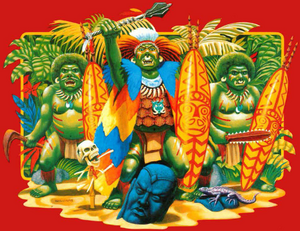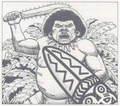Kara-Kara: Difference between revisions
1d4chan>Nubnuber No edit summary |
1d4chan>Nubnuber No edit summary |
||
| Line 1: | Line 1: | ||
[[File:Kara-kara cover.png|thumb]] | [[File:Kara-kara cover.png|thumb|Aloha, yah gitz! I'm da Kahuna uv dis 'ere Luau!]] | ||
'''Kara-Kara''' an obscure humanoid race native to the [[Dungeons & Dragons]] setting of [[Mystara]], implied to be relatives of the [[orc]] that have adapted to life in the tropical ocean regions south-east of Thyatis. They made only two appearances, debuting in the module ''[[X8: Drums on Fire Mountain]]'' and from there making it into the Creature Catalog, and have never appeared again... possibly because they have managed to go down in history as one of the most racist things that [[TSR]] ever produced. | '''Kara-Kara''' an obscure humanoid race native to the [[Dungeons & Dragons]] setting of [[Mystara]], implied to be relatives of the [[orc]] that have adapted to life in the tropical ocean regions south-east of Thyatis. They made only two appearances, debuting in the module ''[[X8: Drums on Fire Mountain]]'' and from there making it into the Creature Catalog, and have never appeared again... possibly because they have managed to go down in history as one of the most racist things that [[TSR]] ever produced. | ||
Revision as of 20:40, 9 February 2021

Kara-Kara an obscure humanoid race native to the Dungeons & Dragons setting of Mystara, implied to be relatives of the orc that have adapted to life in the tropical ocean regions south-east of Thyatis. They made only two appearances, debuting in the module X8: Drums on Fire Mountain and from there making it into the Creature Catalog, and have never appeared again... possibly because they have managed to go down in history as one of the most racist things that TSR ever produced.
If you frequent /tg/, you're probably familiar with the infamous "orcs = people of color" argument. Kara-kara do themselves absolutely no favors by legitimately being based on Polynesian physical and cultural trappings. Seriously, this is their actual physical description from their monster writeup at the end of the module:
- Kara-kara are tribal humanoids distantly related to orcs. They are slightly shorter than humans, and have olive green skin, tangled curly dark green hair, and muzzle-like mouths with curved yellowing fangs. Most wear only loin-cloths, lurid body paint and primitive jewellery. They speak only their own language, which can be understood by creatures who know the orcish tongue.
Add in distinctly Polynesian sounding language (their Witch Doctors are called "Manwu-Papas"), their haka-like tradition of war-chants, their use of outrigger canoes, and... yeah, they've not aged well. If you don't believe us, do a google search and watch out, because people will get heated about the topic.
But you don't want to know about that, you want to know about who the kara-karas actually are. Well, we don't actually know all that much. They are a Stone Age seafaring culture who use outrigger canoes to travel the tropic and semi-tropic waters, often raiding the coastal settlements of other races. Unlike in some of D&D's "evil humanoid" races of the time, a kara-kara settlement always includes as many females as it does males, and will have an average of 1-2 kids per pair of adults. They have no native ability to work metal, but they do understand and appreciate its concept, however they value metal entirely for its utilitarian nature and not as intrinsically valuable in its own right - iron or steel is far more precious to kara-kara than gold, because, well, have you ever tried fishing with a gold fishhook, or cutting down a tree with a golden axe? In battle, they practice war-chanting, singing rhythmic songs to bolster their morale and coordinate their efforts; these make them actually surprisingly nasty in a fight, despite the fact they are normally only armed with stone, wooden and teeth-based weaponry. In terms of spiritual culture, they worship a porcine deity called "Tapu", which causes them to treat pigs and boars as semi-sacred animals - this means there are always a sizable number of large, half-feral hogs in a kara-kara village. In "Drums on Fire Mountain", this causes them to be fooled by a Wereswine masquerading as their patron deity. They also have been known to ride giant horned chameleons as battle animals. That... about sums up everything we are told between Drums on Fire Mountain and Creature Catalog.
For what little it's worth, Mystara has always been rooted in just slapping down real world cultures boiled down to their core cliches/stereotypes and calling it a day - it's an integral part of what makes it a Pulp Fantasy setting. Mr. Welch has used them in his 5e update of Mystara as the local enemies to the also Polynesian-inspired Makai people of Ierendi, treating them as just seafaring tropical orcs who happen to emulate their Makai rivals, just as Mystaran orcs in other nations imitate their greatest enemies. But if you intend to use kara-karas straight up in your own games... well, you have been warned.


